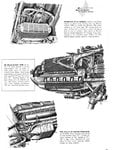That is a question that has been running around my head for a while, how much would the DB601E have improved with C3/96 octane fuel had it, and not the BMW 801 got it in 1942 once cleared for 1350PS?
I see the C3 as the crutch that allowed the 801 to live, what if it is used to help the 601E and prevent the premature introduction of the 605?
I see the C3 as the crutch that allowed the 801 to live, what if it is used to help the 601E and prevent the premature introduction of the 605?


